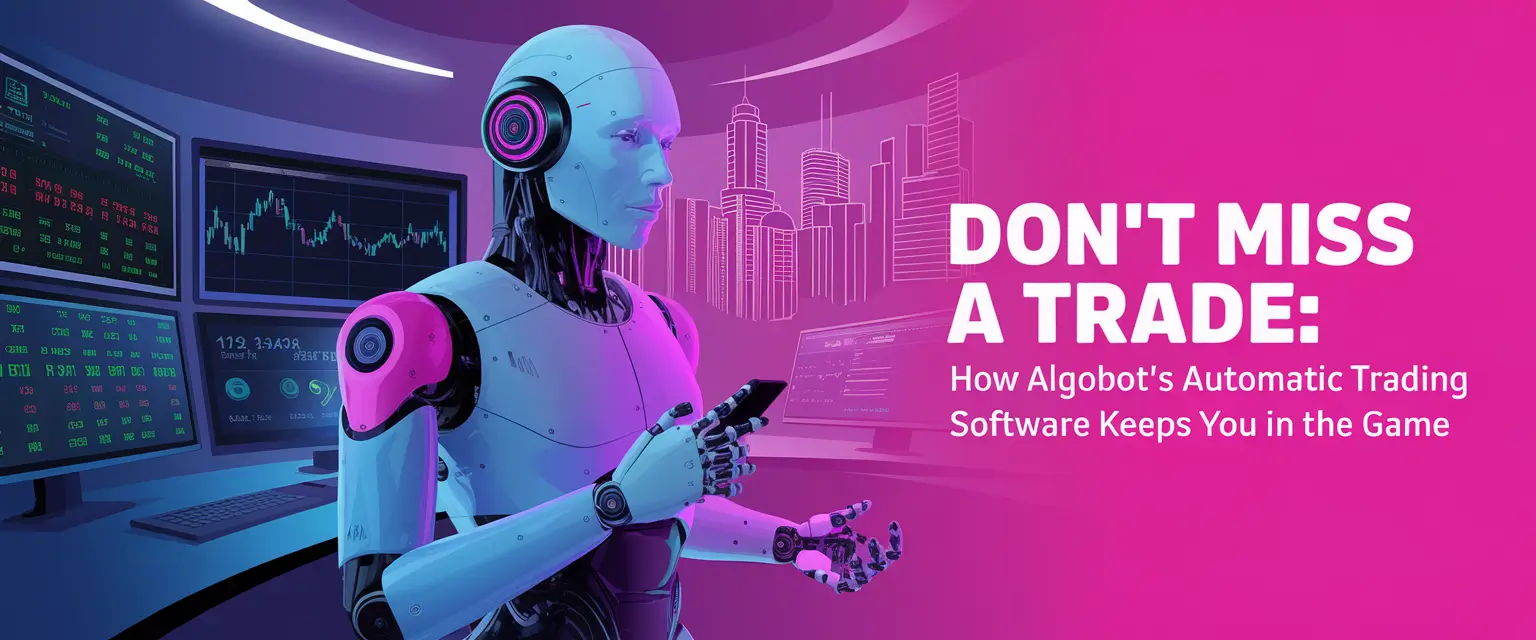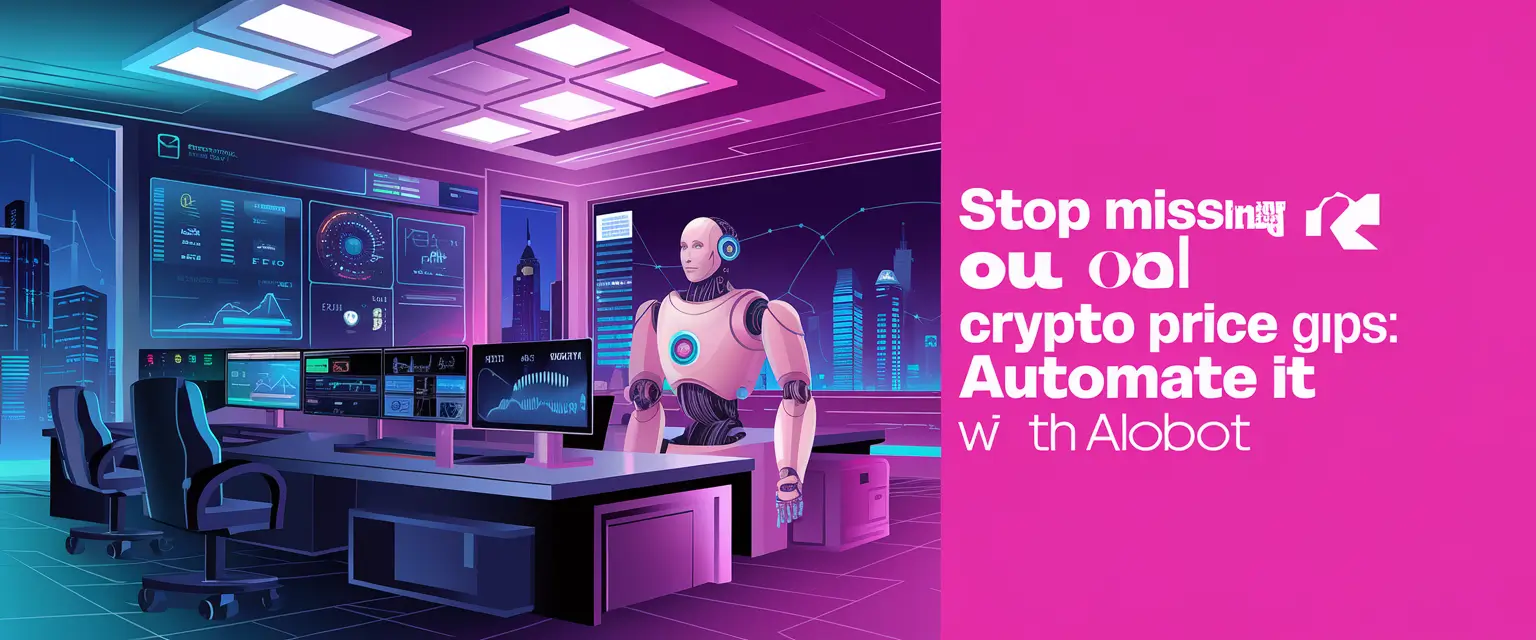Billions of dollars worth of crypto is traded every day. Most traders opt for the spot trading markets. However, it’s also possible to trade crypto with futures. This offers several benefits, such as high leverage levels and the ability to go long or short.
Read on to learn more about crypto futures trading. We explain how the crypto futures space works, how and where to get started, and what risks need to be considered.
Let’s start with the basics – what is crypto futures trading? Futures trading allows you to speculate on the future direction of cryptocurrencies like Bitcoin, Ethereum, and Dogecoin. This is different from spot trading, as you won’t own the underlying digital assets. Instead, futures trading is based on ‘derivatives’, meaning you’re simply guessing whether prices will rise or fall. In the traditional financial space, futures are traded against every asset imaginable. This includes stocks, indices, commodities, and currencies. The industry has now made its way to crypto. This offers crypto traders many benefits. For a start, futures are the best way to trade crypto with leverage. This means you can trade with a lot more than you have in your brokerage or exchange account. For instance, some crypto futures platforms offer leverage of 200x. This means a $10 account balance can be amplified to $2,000. Some platforms offer even higher limits. In addition, crypto futures are also ideal for short-sellers. This is because you can go long or short when trading futures. Put otherwise, you can speculate on both rising and falling markets. This isn’t possible when spot trading. Another benefit of crypto futures is hedging. This can help you protect your crypto portfolio from a sudden market downturn, without needing to cash out. While crypto futures come with many plus points, they’re also a lot more risky than spot trading. This is where crypto trading risk management comes in, which we discuss later.Introduction: What is Crypto Futures Trading?
A Closer Look at How Crypto Futures Trading Works
There’s a lot to learn about crypto futures trading, including many terms you might not previously have come across. Therefore, we’ll now take a much closer look at how this trading space works.
Crypto Futures are Derivatives
First and foremost, it’s crucial to understand that crypto futures are ‘derivatives’. This means they fall into the same category as contracts-for-differences, options, and perpetual swaps. Either way, you do not own the underlying coins when trading crypto futures. This is in contrast to how traditional crypto investing works. For instance, suppose you bought Bitcoin from an exchange like Binance.
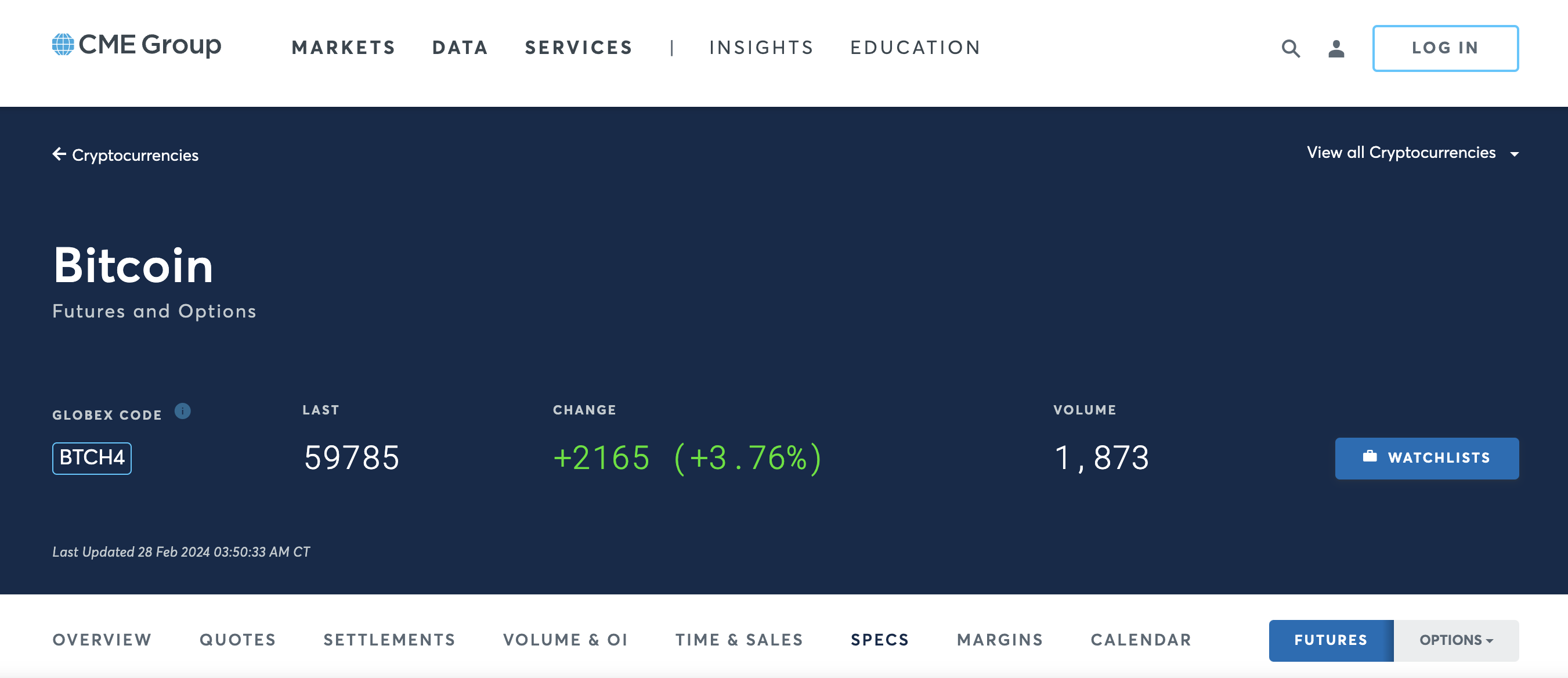
After completing your purchase, you’d likely withdraw the Bitcoins to a private wallet. This gives you full control of your Bitcoins. However, if you opted to trade Bitcoin futures, you wouldn’t be able to withdraw the coins. This is because the futures are simply contracts. They’re a financial derivative, meaning they’re tasked with tracking the underlying market.
Strike Price
You’ll come across the ‘strike price’ when trading crypto futures. It’s important to understand how this differs from the current market price.
- Let’s suppose that you’re trading 3-month Ethereum futures. The current price of Ethereum is $3,000.
- However, the strike price attached to the Ethereum futures is $3,300.
- From your perspective, you need to assess whether Ethereum will be worth more or less than $3,300 when the futures expire.
- If you speculate correctly, you’ll make a profit.
The strike price is determined by market forces based on demand and supply. This is based on what price the market believes the crypto will be worth on the future’s expiry date.
Contract Expiry Date
Traditional futures contracts come with an expiry date. That said, there are many different types of futures, some are perpetual – meaning they never expire. We’ll dive into the different types of crypto futures contracts later on. In the meantime, we assume you are trading ‘delivery futures’. In a nutshell, delivery futures always expire on a specific date.
This could be next week, month, quarter, or year. In all instances, the futures will be settled when on the expiry date. This is based on the current market price. Whether you make or lose money depends on the original strike price and whether you were long or short.
- For example, let’s say you’re trading Bitcoin futures.
- The futures expire in 3 months.
- The strike price is $50,000.
- You believe Bitcoin will be worth more than $50,000 in 3 months’ time.
- Therefore, you’re buying long futures.
- In 3 months, the futures expire. Bitcoin is priced at $55,000, which is the same price that the futures are settled.
- So, for $50,000 invested, you’ve made a $5,000 profit.
Contract Size
It’s crucial to understand how the contract size works when trading crypto futures. For example, consider Bitcoin futures on the CME Group exchange. Each futures contract is valued at 5 BTC. So, if Bitcoin is trading at $50,000, each contract would be worth $250,000.
Without leverage, this means you’d need $250,000 to open a position, regardless of whether you’re long or short. That said, the CME Group is aimed at institutional traders. Fortunately, many crypto futures trading platforms cater to retail clients. This means you can trade with much smaller minimums.
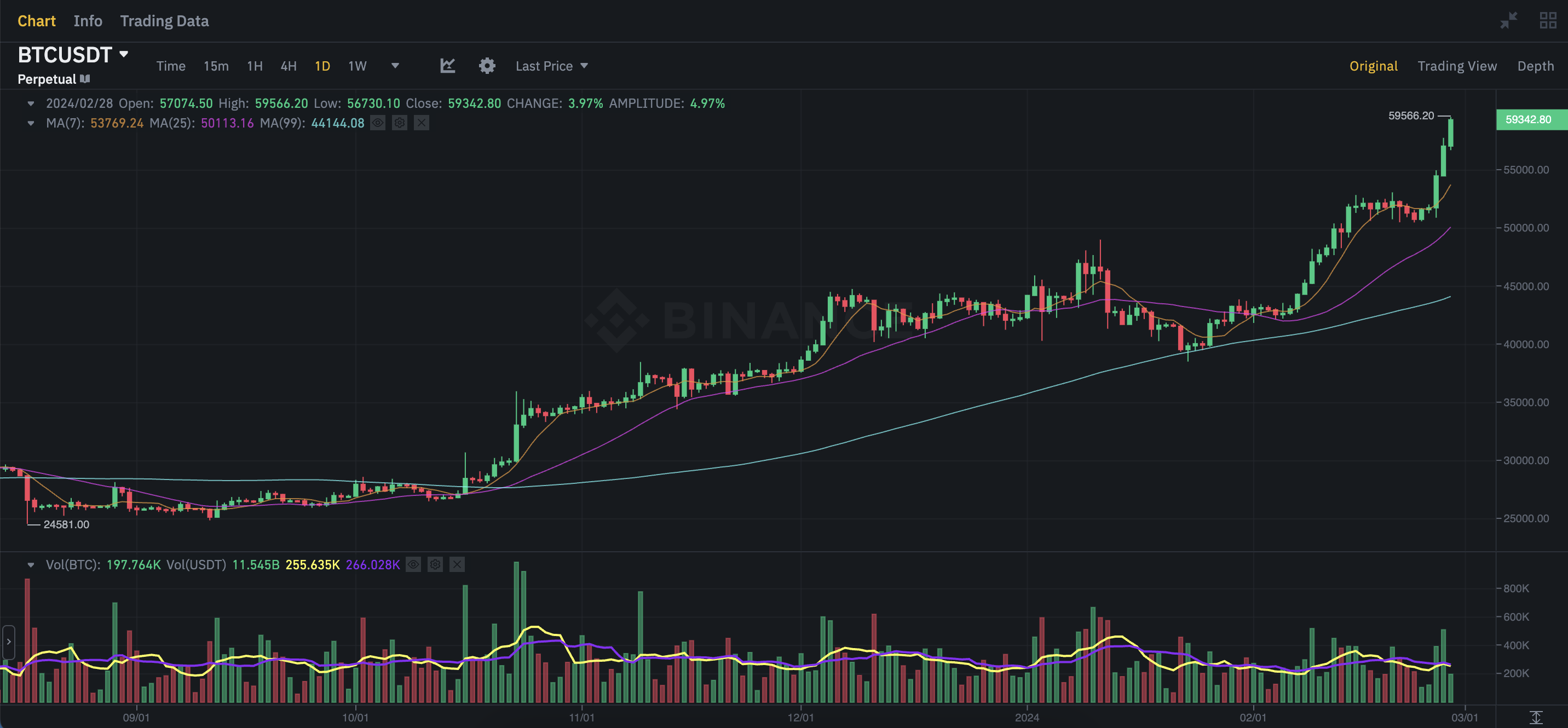
Nonetheless, let’s look at an example of how contract sizes work when crypto futures trading:
- Let’s say you’re using a platform that has a 0.01 BTC contract size. If Bitcoin is trading at $50,000, this means the minimum outlay is just $500. This is without using leverage.
- So, we’ll say the futures strike price is $60,000. You go long, meaning you believe Bitcoin will be worth more than $60,000 when the futures contracts expire.
- You buy 10 contracts. Each contract is 0.01 BTC or $500. Therefore, your total outlay on this trade is $5,000.
- Upon expiry, Bitcoin is trading at $61,000. This is $1,000 above the strike price of $60,000, meaning you speculated correctly.
- You purchased 10 contracts, so your total profit on this trade is $10,000 ($1,000 per contract x 10 contracts).
Of course, had Bitcoin closed below the $60,000 strike price, you would have made a loss.
Vanilla Futures vs Exotic Futures
We’ve established that delivery futures come with an expiry date. Depending on the type of crypto futures you’re trading, you don’t necessarily need to hold onto the contracts until they expire. For instance, if you’re trading vanilla futures, these offer full flexibility. Meaning – you can cash out your position at any time, on or before the expiry date. This is ideal for risk management purposes.
- For example, suppose you’re short on XRP futures. You took a strike price of $0.50. This means you need the XRP price to fall below $0.50 to make a profit.
- Unfortunately, a news story has just broken, explaining that a tier-one bank will now use XRP exclusively for its cross-border payments. As such, the XRP price continues to rise.
- In this instance, waiting until the XRP futures expire could be costly. Instead, you decide to cash out the futures as soon as the news announcement is made. While you made a loss, you’ve reduced your exposure considerably.
Vanilla futures are also ideal for locking in profits early. For example, suppose you’re long on Bitcoin futures. You took a strike price of $40,000. Bitcoin is currently trading at $42,000 with just three days until the futures expire. Rather than risk a potential loss, you could cash out the futures, locking in a slight gain.
However, not all crypto futures platforms offer vanilla-style contracts. Some offer exotic futures, which come with more complex terms. One of which is that the futures must be held until expiry. Ultimately, it’s crucial you know what type of crypto futures you’re trading – especially when it comes to expiration.
Going Long or Short
We’ve mentioned that crypto futures trading allows you to go long or short. This is a significant advantage, as short-selling isn’t possible when spot trading crypto. As such, you can attempt to profit from both rising and falling markets.
Let’s look at a couple of examples of how each futures trading position works:
Example 1: Going Long on BTC/USD Futures
Example 2: Going Short on ETH/USD Futures
Type of Crypto Futures Trading Contracts
There are several different types of crypto futures that can be traded online. Availability will depend on your chosen platform.
Nonetheless, let’s explore the most common futures markets for crypto traders in 2025:
Perpetual Futures
We mentioned earlier that traditional futures contracts come with an expiry date. However, the most popular futures markets in crypto are ‘perpetual’. In simple terms, perpetual futures never expire. In this sense, they operate similarly to the spot trading markets. This is because you can keep perpetual futures open for as long as you want.
However, like all futures markets, perpetuals are derivatives – meaning you don’t own the underlying assets. Nevertheless, perpetual futures are the easiest to trade. This is because you don’t need to worry about approaching expiry dates. What’s more, perpetual futures are cheap to trade and they often come with the lowest margin requirements. This allows you to trade with significantly more than you have in your account.
We also found that perpetual futures offer access to a much larger range of markets. Sure, they cover major coins like Bitcoin, Ethereum, and XRP. But you can also trade perpetual futures against up-and-coming cryptocurrencies with smaller valuations. Crucially, perpetual futures usually mirror the underlying asset’s current market price. This is in contrast to traditional futures, where prices are predicted based on the date of expiry.
Delivery Futures
Delivery futures are used in the traditional financial space. They track everything from gold, silver, and US dollars to Apple stock and the S&P 500. Delivery futures have also made their way to the crypto trading markets. As mentioned, delivery futures always come with an expiry date. This could be anywhere from a few days to a year.
What’s more, delivery futures have a strike price. This is based on market forces.
- For example, suppose you’re looking at Bitcoin delivery futures with a 3-month expiry.
- Today, the price of Bitcoin is $60,000.
- However, the strike price of the 3-month futures is $65,000.
- This means the market consensus is that when the futures expire, Bitcoin will be worth $65,000.
Your job as a futures trader is to determine whether the actual market price will be higher or lower than the strike price.
- Let’s say you believe Bitcoin will be worth more when the futures expire.
- We’ll also say that 1 futures contract is worth 1 BTC. You decide to buy 10 contracts.
- Bitcoin is trading at $75,000 on the expiry date.
- This is $10,000 above the strike price of $65,000.
- This means you made a $100,000 profit, as you bought 10 contracts.
Don’t forget to check if you’re trading vanilla or exotic futures. Vanilla futures are always the best option, as you aren’t required to hold until expiry. As such, you can offload your delivery futures at any time, based on current market prices. If you’re trading exotic futures, this might not be possible.
All that being said, most crypto futures trading platforms offer vanilla-style futures, but it’s worth checking nonetheless.
How Crypto Futures Trading Differs From Spot Trading
The futures and spot trading markets both allow you to speculate on crypto prices. While there are some similarities, there are also some clear differences.
Spot trading markets allow you to directly invest in cryptocurrencies. For example, suppose you buy Bitcoin from an online exchange. You’re buying from the spot markets, meaning you can withdraw your coins to a private wallet. This is because you won the underlying Bitcoins. If the spot market price of Bitcoin increases, you can sell your coins for a profit.

In contrast, futures are derivatives. This means futures are a contract between you and the underlying trading platform. As such, you don’t own anything when you trade crypto futures – even if you’re long. Instead, you’re merely speculating on the future price of the asset. What’s more, unless you’re trading perpetuals, there’s usually a disparity between spot market and futures prices.
Let’s summarize some of the key differences:
| Spot Trading | Futures | |
| Ownership | You own the underlying coins when spot trading crypto. So, if you buy 1 ETH, you own 1 ETH | Futures are derivatives, so you never own the underlying coins |
| Price | Prices are determined by immediate supply and demand metrics |
Prices are determined by the expected future value of the underlying crypto
|
| Settlement | Settlement is instant, meaning ownership is transferred as soon as the trade is completed |
Futures are settled when they expire. The only exception is perpetual futures, which never expire
|
| Leverage | You can’t obtain leverage when spot trading, as you’re simply buying coins |
Futures allow you to speculate on crypto with leverage. Some platforms offer leverage of up to 200x
|
| Direction | Spot trading only allows you to go long on crypto. For instance, you buy Litecoin because you think its price will increase |
Futures allow traders to go long or short. This is because futures are merely contracts
|
How Do Fees Work When Trading Crypto Futures?
Crypto futures trading platforms charge fees, just like any other financial instrument. There are two important fees to look for when choosing a platform.
First, you’ll need to pay a trading commission, which is usually a small percentage of the investment amount. This is charged when you open a futures position and again when you close it. Now, you’ll find that at face value, futures commissions are often cheaper than spot trading. However, upon closer inspection, you’ll realize that futures commissions are based on the overall contract value – including leverage.
For instance, let’s say you’re willing to risk $500 on a Cardano futures contract. The platform charges a commission of 0.1%. Ordinarily, you’d pay just $0.50 to enter the market (0.1% of $500). However, you apply leverage of 100x, which increases the contract value to $50,000. This means you’re now paying a commission of $50 (0.1% of $50,0000)
The second, and most consequential futures trading fee is based on the leverage you deploy. Nothing is free in life; especially leverage. After all, you’re essentially taking out a short-term loan from the futures platform. This will incur interest while the futures position remains open. This is usually charged once per day.
The financing fee will be deducted from your margin balance. Leaving a futures position open for too long can mean that financing fees eat away at your potential profits. Therefore it’s crucial to know how much you’re paying before entering a trade.
Benefits of Crypto Futures Trading
Let’s take a closer look at the benefits of crypto futures trading.
Profit From Rising and Falling Markets
Futures are suitable to trade in all market conditions. This is because futures enable you to go long or short.
- When you’re bullish on a crypto coin, you can purchase long futures. This means you’ll make a profit if the coin increases in value.
- When you’re bearish on a crypto coin, you can purchase short futures. This means you’ll make a profit if the coin decreases in value.
Ultimately, you’ll have lots of flexibility when trading futures. For example, consider that the broader crypto markets were bearish for most of 2022. During this period, short futures would have enabled you to profit from declining prices.
Increase Your Market Exposure by Substantial Amounts
Another major benefit of trading crypto futures is that they support leverage. This means you only need to put up a small percentage of the overall trade value. Meaning – you can trade with a lot more than you have in your futures account.
- Some crypto futures platforms offer 200x leverage on major pairs like BTC/USD
- Let’s say you deposit $1,000 into your account
- You apply the full 200x leverage to a BTC/USD long order
- This means your BTC/USD position is worth $200,000
- BTC/USD increases by 5%, meaning you’ve made a $10,000 profit (5% of $200,000)
- Without leverage, you would have made just $50 ((5% of $1,000)
Be careful when deploying high-leverage limits. Liquidated trades are all too common in the crypto futures space. We talk about the risks of liquidation shortly.
Ideal as a Hedging Tool
Futures are one of the best financial instruments for hedging strategies. For example, suppose you’re currently overexposed to a Bitcoin long order. While you’re confident about the long-term outlook, you’re concerned about a potential market decline in the short-term.
This is due to increased regulatory scrutiny on Bitcoin ownership. Instead of selling your Bitcoin holdings, you decide to purchase some short BTC/USD futures. This means that any short-term price movements will be countered.
Meaning:
- If you get some bad news about Bitcoin, its price will decline. This means your portfolio takes a hit. However, these losses are countered by the short Bitcoin futures you purchased.
- Conversely, if you get some good news about Bitcoin, your portfolio will increase. And your Bitcoin futures will decline.
- This means that in both scenarios, you’ve neither gained nor lost. Meaning – your futures heading strategy was a success.
Risks of Crypto Futures Trading
Like any investment product, crypto futures also come with risk.
Liquidation Results in a Loss of Margin
Your biggest risk when trading crypto futures in liquidation. In simple terms, this means the exchange will close your futures trade. In doing so, you’ll lose the margin that you originally put up.
- For example, let’s say you’re trading Solana futures with 20x leverage.
- You put up a $200 margin. This means your Solana futures contract is worth $4,000 (20 x $200).
- As such, your $200 margin represents 5% of the futures trade value.
- This is risky, as the trade will be liquidated if it declines by 5%.
- If this happens, the trade is closed and the exchange keeps your $200 margin.
The only way to avoid liquidation is by adding more margin to your account. You’ll usually receive a margin call when you’re getting close to the liquidation level. However, if you’re trading in overly volatile markets, your futures trade might get liquidated before you get a chance to add more funds.
The best way to reduce the risk of liquidation is to lower your leverage levels. For example, we mentioned that at 20x leverage, your liquidation point is 5%. If you only apply 5x leverage, this reduces to 20%.
Daily Financing Fees
Financing fees can have a major impact on your ability to make a profit. This is because financing fees are usually charged each day that your futures position is kept open. This is because futures are leveraged products, so they attract interest. As a result, futures trading isn’t the best strategy for long-term investors.
Moreover, daily finance fees are deducted from your margin account. This means you’re constantly getting closer to the liquidation point. The only workaround is to keep adding more funds.
Once again, the best way to reduce this risk is by reducing your leverage limits. In doing so, you’re borrowing less funds from the platform, which means lower interest payments.
Counterparty Risks are Increased
Counterparty risks are always an issue when trading crypto online. After all, there needs to be an element of trust between you and the trading platform. This level of trust increases substantially when trading crypto futures. This is because, unlike spot markets, futures contracts are an agreement between you and the exchange.
This means that the exchange must honor any profits you make. While reputable exchanges have various risk management tools in place, there’s always a risk of non-payment. This highlights the importance of using a trusted futures platform. For example, it’s best to stick with regulated crypto futures platforms that have a prolonged track record in this space.
Getting Started: Best App for Crypto Futures Trading
You’ll need an account with a suitable crypto futures trading platform before getting started. After that, you’ll need to make a deposit and set up a futures trading order.
This section discusses some of the most popular platforms in the market today. Read on to select the best app for crypto futures trading in 2025.
1. MEXC – Trade Crypto Futures With 200x Leverage
The first option to consider is MEXC. Launched in 2018, MEXC is now one of the largest crypto exchanges for trading volume. In addition to spot trading, MEXC offers a huge range of futures markets. This includes more than 100 perpetual futures that are settled in USDT. Popular markets include Bitcoin, Shiba Inu, Dogecoin, Litecoin, Ethereum, and BNB. MEXC also offers futures markets that are settled in the underlying crypto.
We found that MEXC offers some of the highest futures leverage limits in the industry. Some markets can be traded with 200x leverage. Even lower-cap coins come with leverage of over 100x. In addition, MEXC charges 0.01% per slide when trading futures. This is charged when entering and exiting the market. If you’re not sure how to trade futures on MEXC, consider the copy trading feature.

This enables you to pick a successful futures trader that uses MEXC. After selecting your stake, you’ll automatically copy the futures trader. This means you’re buying and selling crypto futures passively. In terms of payments, MEXC has partnered with third-party fiat gateways. This enables you to deposit funds with a debit/credit card and other popular methods. However, do note that like many crypto futures platforms, MEXC isn’t regulated.
Pros:
Cons:
2. Binance – Top-Rated Futures Platform for High Liquidity
The next option to consider is Binance. As the world’s largest spot trading exchange, it will come as no surprise to learn that Binance offers significant futures liquidity. This ensures that you can enter and exit futures positions with ease. Not only with large-cap coins but also trending small-caps. More than 100 cryptocurrencies are available in the Binance futures department.
This covers everything from Bitcoin, Ethereum, and XRP to EOS, Compound, and Dogecoin. All futures markets can be traded with leverage. Limits vary depending on the market. There are two contract categories to choose from when trading futures at Binance. First, you can trade perpetual futures, which are settled in USDT. Alternatively, you can also trade quarterly futures.
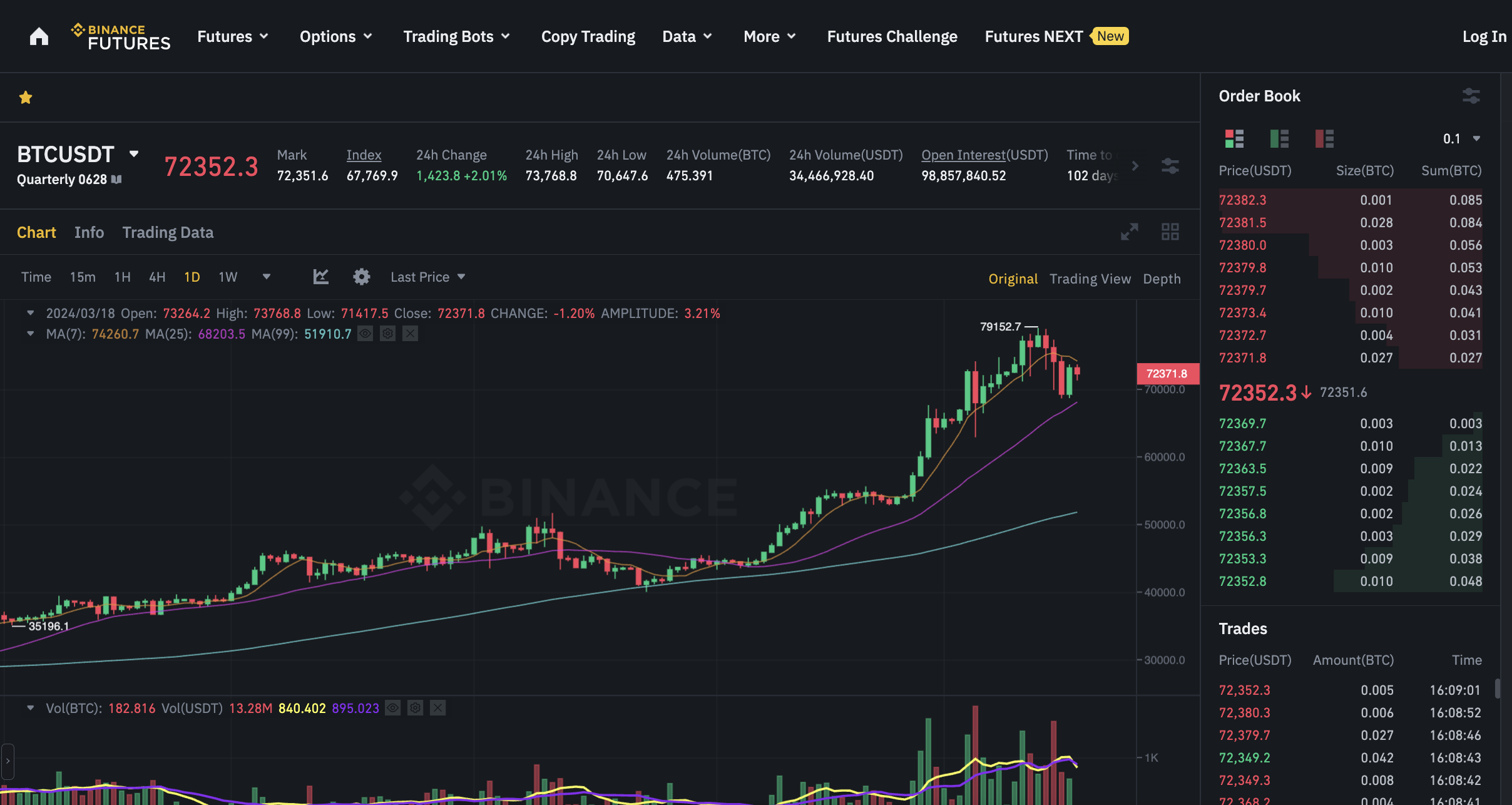
Also settled in USDT, quarterly futures are more suitable for experienced traders. Either way, Binance offers plenty of charting tools, indicators, and in-depth order books. This ensures you can make informed trading decisions. Getting started with Binance takes seconds and most nationalities can deposit funds with fiat money. Fees will vary depending on the currency and payment type.
Pros:
Cons:
3. Bybit – Trade BTC/USDC Futures With a 0.8% Margin Requirement
Bybit is also one of the best places to trade crypto futures. This is the largest crypto derivatives exchange after Binance; more than $23 billion has been traded in the prior 24 hours. Bybit is known for its advanced trading tools, high-level indicators, and fast execution speeds. It’s also one of the leading exchanges for low-margin requirements. For example, you’ll only need a 0.8% margin to trade BTC/USDC.
This means you can open a $1 million futures position with just $8,000. These are perpetual futures supporting long and short positions. Bybit supports many other perpetual markets, including Ethereum, Solana, and Cardano. It also supports meme coins like Dog Wif Hat, Book of Memes, and Myro. Bybit is also one of the best options for trading delivery futures.
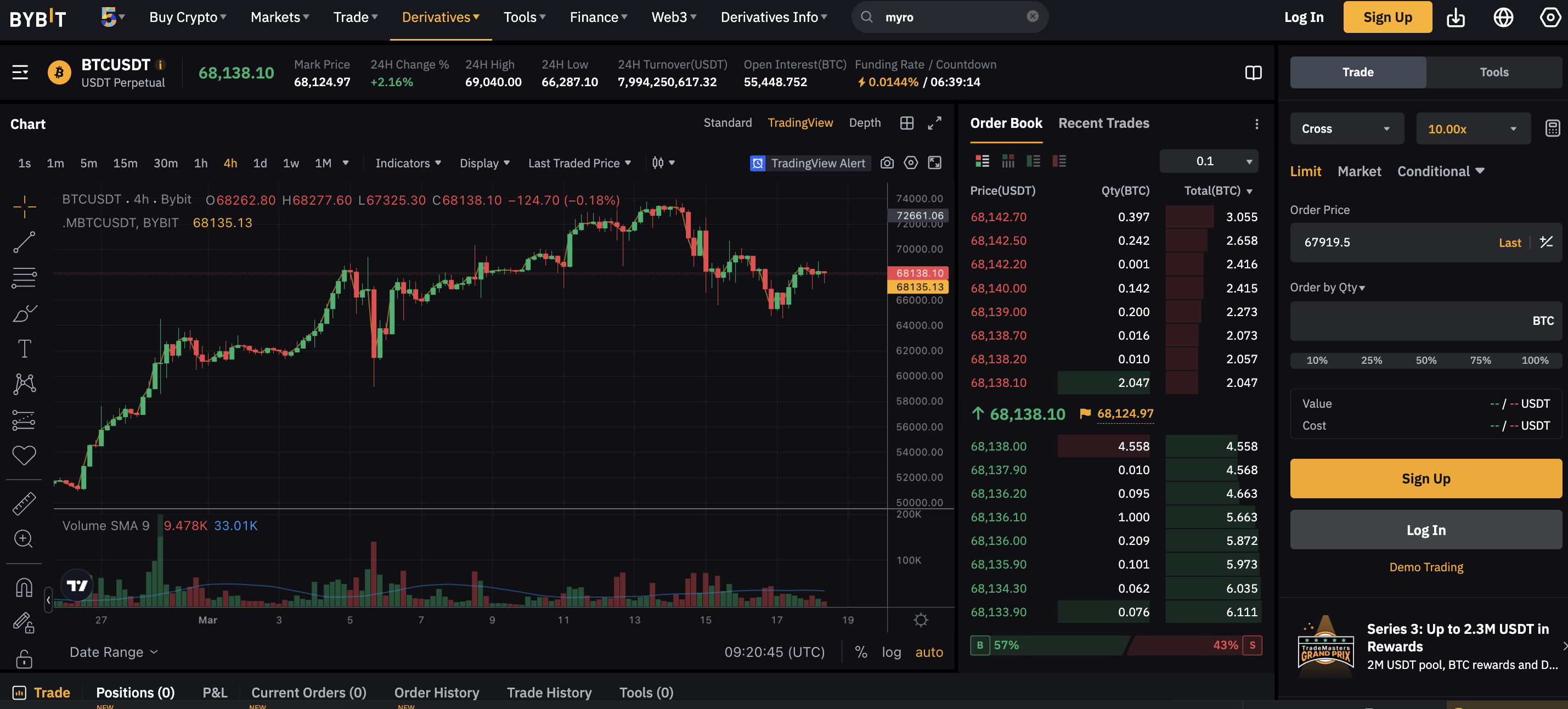
Although only Bitcoin and Ethereum are supported, plenty of settlement dates are available. In terms of fees, Bybit operates a market maker/taker model. Discounted fees are available when meeting minimum trading milestones. As an entry-level futures trader, you’ll pay 0.055% per slide. Bybit doesn’t directly accept fiat money. It does, however, support third-party fiat gateways. This allows you to instant deposit funds with a debit/credit card.
Pros:
Cons:
Best Practices When Trading Crypto Futures
Most people lose money when trading crypto futures for the first time. With this in mind, we’ll now discuss some best practices to follow. This will give you the best chance of being a successful futures trader from the get-go.
Start With a Demo Trading Account
Crypto futures are complex financial instruments. You’re dealing with a volatile asset class but on steroids. After all, futures are traded with high leverage levels, which further increases the risks. As such, it’s best to start with a demo trading account. These typically mirror actual trading conditions, but you won’t be risking any funds. Instead, you can place long and short positions with demo funds.
Evaluate how you’re performing after a few days. Assess individual positions and see where you could have improved. The worst-case scenario is that you blow through your demo account. These are virtual funds, so you’ve lost nothing. Ultimately, you should remain in demo mode until you’re consistently making profits.
Keep Leverage Limits Sensible
One of the biggest attractions of crypto futures is that they invite high leverage limits. This means you can trade with substantially more than you have in your account.
- For example, we mentioned that MEXC offers leverage of up to 200x on perpetual futures.
- This amounts to a minimum margin requirement of just 0.5%.
- Put otherwise, you only need to put up 0.5% of the total position value.
- Suppose you want to trade $100,000 worth of Bitcoin.
- At a margin requirement of 0.5% you’d only need $500 in your MEXC account.
However, if your Bitcoin futures trade goes against you by 0.5%, your position will be liquidated. Not only does this mean your position is closed but you’ll lose the $500 margin requirement.
As a result, we strongly suggest that you keep your leverage limits sensible – at least until you feel more comfortable. For example, consider starting with 2x leverage. This converts to a margin requirement of 50%. So, as long as your position doesn’t decline by 50%, you’ll avoid liquidation.
Stick With Large-Cap Futures
Another best practice is to stick with large-cap futures markets. This means trading market leaders like Bitcoin and Ethereum. These markets come with the least amount of speculation and liquidity. This will help you avoid a margin call, and ultimately – liquidation.
In contrast, trading small-cap futures markets can be extremely risky. This is because volatility levels are often enhanced, making it challenging to trade in a risk-averse way.
Stop-Loss and Take-Profit Orders
Never enter a crypto futures position without a solid entry and exit strategy. This means entering a position at the most favorable price. It also means setting stop-loss and take-profit orders. This will close your futures position when one of these orders are triggered.
For example, stop-loss orders ensure that you never lose too much money. There’s no right or wrong stop-loss level to set, as it all depends on your individual strategy.
- Nonetheless, let’s say you want to limit your losses to 10%.
- You enter a long BTC/USDT futures trade at $55,000.
- Your stop-loss order must be set 10% below your entry price of $55,000. That’s $49,500.
So, if your BTC/USDT trade goes against you by 10%, the futures contracts will automatically be sold. This means you take a 10% loss. However, your losses could have been much higher had you not entered a stop-loss order.
Entering a take-profit order will close your position once it reaches your desired profit target.
- Let’s you want to make a 40% profit on an ETH/USDT long futures trade.
- You enter the market at $4,000.
- 40% above your $4,000 entry price is $5,600.
So, if ETH/USDT hits $5,600, the futures contracts will be sold. This means you’ve locked in a 40% profit.
Unless you’re a seasoned futures trader, making consistent gains in this space is a tall order. You’ll need to have a proven strategy in place. Not to mention a robust risk management framework that you follow religiously. If you have little to no experience but still want to trade crypto futures, consider what Algobot can do for you. Algobot is an algorithmic bot that trades the spot and futures markets. It has a historical win rate of 82% and can trade all time frames. Best of all, Algobot can connect with third-party trading platforms. This means Algobot can trade futures on your behalf 24 hours per day, 7 days per week. Simply follow the step-by-step instructions provided once you’ve chosen a subscription plan.Use a Proven Futures Trading Bot
Conclusion: Navigating the Future of Crypto Trading
This guide has answered the question – what is crypto futures trading? In summary, the crypto futures market can be lucrative – especially when trading with high leverage limits. Equally, however, crypto futures are complex and risky, meaning that most traders lose money.
A great alternative is to use Algobot, a fully autonomous futures trading bot.
Algobot will go long or short on your behalf, allowing you to trade futures around the clock passively. And unlike human traders, Algobot doesn’t trade futures based on emotions or speculation. This ensures Algobot makes consistent gains in a risk-averse way.
FAQs
How do you trade in crypto futures?
You’ll need an account with a crypto futures platform like MEXC, Binance, or Bybit. Choose a perpetual futures contract (e.g. BTC/USDT) and place an order (long or short).
Is trading crypto futures worth it?
Crypto futures trading is an advanced strategy aimed at seasoned traders. Not only do futures allow you to go long or short but you can trade with high leverage limits.
Which crypto is best for future trading
Beginners should focus on large-cap futures markets like BTC/USDT or ETH/USDT. Experienced traders might consider more exotic markets, such as meme coins or small-cap cryptocurrencies.
What are perpetual futures in crypto?
Perpetual futures are similar to traditional futures, as you need to speculate on whether the asset price will rise or fall. However, unlike traditional futures, perpetuals never expire, as they don’t have a settlement date.

